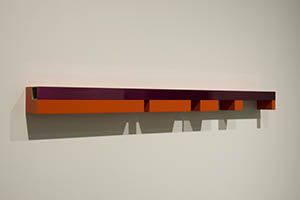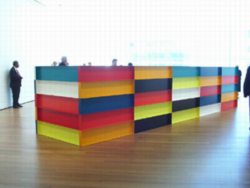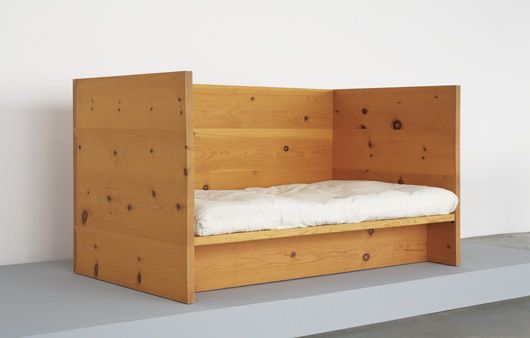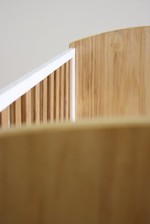When we last saw the Donald Judd daybed-inspired plywood toddler bed I was trying to get made, it looked like this:

Just out of sight to the left is the meter, ticking away as I contemplated the invisibility of various joinery methods, the jigs needed to drill holes along the edges of each edge, the type of finishing that'd be necessary, the way the bed safety rail, and later, the cribfront, would attach...
Anyway, the bed sat nearly finished for much of last year, which also happened to be the time when the kid outgrew it, and when our desperate need for a toddler bed in NYC nearly evaporated because the kid was spending less extended time there.
As a bed, it's actually finished; we could throw the kid's organic toddler futon on there tomorrow and be happy as clams. Though 1-inch-thick orange plexi turned out to be too expensive to source for a prototype, the bed rail looks exactly like the schematic above, which I sent off to the plexi guy. It's got rounded edges, and is pretty sweet. Though you could screw it in, the weight of the mattress--plus kid, when inhabited--holds it in place just fine. All in, it cost around $150-180, I can't remember exactly.
But the bed rail's in storage. We decided, with the other kid here, we would finish the thing off, and press it into use as a crib instead, which means figuring out the crib front.

Donald Judd, Untitled (Wall Sculpture) Orange and Purple, 1965 [via]
Here's what I had cooking until last week. The crib's a tinier, re-proportioned version of a piece of Donald Judd's furniture [a double mattress-sized daybed, though I later found out he made one twin bed version, he never did a kid-sized bed or a crib] and I wanted to stick with Juddy references. Judd did a series of wall-mounted sculptures called Progressions which consist of a series of solid cubic elements and voids joined together by a long, horizontal top piece. The Progressions are fabricated out of metal, usually, and the dimensions are based on a double Fibonacci sequence [i.e., the solids get cumulatively bigger from one side, and the spaces get cumulatively wider from the other.] The example above is from the Phoenix Art Museum.
So initially, I figured I'd frame up a crib front like a screen door, alternating plywood and plexiglass--plywood for strength, with thinner plexi inset, maybe with a gap where it's within the 2 3/8" CPSC limits. Then we'd just clamp this in place along the sides. [I really don't want to screw into the sides of the bed, and obviously, you can't have any hardware or protrusions inside.]

But as I kept looking around Google for more progression images, I kept seeing images of Judd's later works from the 80's which are essentially assemblages of multicolored metal shadow boxes [ like this, this, and the giant Judd box-of-boxes which was on view when MoMA reopened in 2004, and shot here by Chris Ashley in May 2005.]
You see where this is going. Between the quilt and the art and the Gerhard Richter stained glass window in the Cologne Cathedral which is the wallpaper on my phone at the moment, I now think the crib front will look a little like this. 1/4-in. colored plexi is cheap and easy [to find], and I'm talking to my plexi guy about fusing up a grid of colored rectangles and then doubling it with a solid sheet of 1/4-inch clear.
It'll probably weigh a ton. It'll probably look good hanging in the window when the other kid graduates to a toddler bed. It'll probably cost a couple hundred dollars, easy. Which means it's not really viable as a solution for the crib as I first envisioned it: as a sweet, DIY-able, sub-$500 modernist crib that someone could buy, have made, or build themselves.
[The bed itself is still designed to be a solid bargain; minus whatever piece(s) you put on the front, the pieces are designed to be CNC-routed, two at a time, from five 60x60-in. sheets of FSC Baltic birch ply, which ship flat. If you don't need to take it apart, you can glue and biscuit it together and be done. Or now, there's the invisible, channel-mounted cleats that allow it to be knocked down, too. It's really just the front that's the unknown.]
So though we'll be fine, I think the drawing table is still open for figuring this thing out. Any thoughts, suggestions, feedback, etc. will be welcome. After the jump, some thoughts on the knockoffery aspects of this project and why I don't think I'm as big a knockoff hypocrite as some might think I am.
Previously: The DT Crib Blog [sic]; The Crib Blog update & Enzo Mari's Autoprogettazione

I've addressed some of these issues as I went along in this Juddy crib project. But since starting it, I've also harshed pretty publicly on folks who knock off other peoples' furniture and designs, especially if they've done so for their own financial gain, or in an attempt to encourage others to knock off with them.
So have I just rationalized myself into a corner, or does this project look and feel quite different to me--and hopefully to others? Because while I'm very upfront about the source of my inspiration, I don't think this crib is a knockoff of Judd's own design, but a takeoff from and reworking of it.






I don't know that anyone has ever looked at it using real science, but one of the sort of unwritten baby industrial complex crib design rules is that cribs need ventilation, or some way for air to circulate. Hence slats. I presume it's something somebody came up with when SIDS started to become a big issue.
As for attaching it- it sounds like you want to keep the sides totally undrilled so it looks clean after conversion back to a day bed. Why not use the same fixing method you used for the guardrail, but more? Make the crib side a right angle piece where the flat section fills the entire mattress area (and I suppose you ought to screw it down with a baby). The trick will be making it stiff enough that you can't open a finger-pinching gap up by pushing on the top edge. How about instead of plywood, using aluminum rectangular tubing, powdercoated in the colors you want?
[yeah, we're perforating the mattress platform for that reason, and at least during the first few months until she can sit up/pull up, we'll raise the mattress platform higher with a kludgy fix like putting some boxes under it, and putting another base platform down. with the pressure off to make a "product" and the pressure on to have a place for the kid to sleep safely. some temporary aesthetic sacrifices will be made. I like the aluminum tube idea, too. also very Juddy. and a helluvalot lighter than plexi. -ed.]
Can we get a photo of the "invisible, channel-mounted cleats"?
Could there be a solution that doesn't use any hardware, but slides over the bottom piece of ply and is held in place by physics like these bookends from e15? (photo from Books at Home). This could be the attachment scheme and you could pretty much have anything welded to the top.
[I'll get a pic. those bookends are nice. The underside of the front edge is totally fair game, as is the topside, under the mattress, like Scott suggested. Then all it'd take is something clamping it in place on the top edge, and for there to be no gap--or no pinchable gap, anyway--along the sides. -ed.]
[wha? "Books at Home: a blog about bookshelves"?? -ed.]
Well, it's a total knock-off so far, but it's also a really obvious one, as it's just a big box. Does that make you a hypocrite? Does it make Judd's bed art? Did he steal the idea himself in the first place?
In a condo rented by family members a decade ago there was a set of stacked beds just like this one -- white laminate, if I recall correctly. Hideous and as uncomfortable as can be, sad to say. Were those Judd knock-offs, or just expedient mundanes?
And of course there are all those ancient European beds-in-alcoves. (See, for an ornate example, this from the V&A.) (Ignore the couches in front, they're not relevant.)Take the surrounding walls away, and Judd's box is pretty much what you've left with, with or without decoration.
Personally, I think there's a big difference between incorporating an idea for personal use -- and dealing with the attendant miseries and difficulties -- and knocking off a product to sell. Not to mention that you've certainly documented your sources thoroughly.
So far, however, I don't buy the idea that your design elements are significantly different from Judd's, though it certainly looks as if you're headed that way. But whoever paid $70,000 for the Judd twin clearly had more money than something . . .
[judd explicitly considered his furniture to be something other than art, though at recent prices, it's clear he's in the minority. -ed.]
Listen you're making this crib for personal use, you have no plans to market it (do you?). You have been inspired by an artist's work, and using that inspiration as a springboard for your own design. You're not making a copy, you're taking ideas and reworking them to suit your project. It's not something I'd spend another minute worrying about, if I were you.
But I could be biased. I have my own bed idea brewing, inspired by a product made in Scandanavia that can't be shipped. I'd like contact your plexi source, if you don't mind sharing. I'd like to talk to someone besides Canal Plastics.